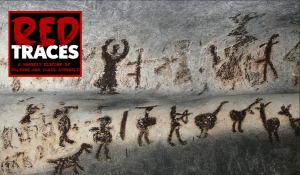
Red Traces: A Marxist history of culture and class struggle
Sean Ledwith introduces his new book
The past is never dead. It's not even past. - William Faulkner
The essays are written in the spirit of Leon Trotsky’s writings in the 1920s on art, culture and science. Amid the turmoil of playing a leading role in governing the world’s first workers’ state, Trotsky believed it was also important to demonstrate that Marxism - the presiding ideology of the new regime - has persuasive explanatory power when it comes to analysing the full spectrum of human activities. In two books, Problems of Everyday Life and Literature and Revolution, he brilliantly addressed a range of questions not normally associated with the concerns of historical materialism.
In the latter, for example, Trotsky discusses both the historical forces in thirteenth century Italy that led Dante the poet to create The Divine Comedy and the reasons such a cultural artefact would still resonate centuries later. In the former, he explains how it can be illuminating to consider that the year 1871 witnessed both the Paris Commune and Mendeleyev’s prediction that there would be new elements to be added to the Periodic Table. Trotsky’s materialist method to culture in the widest sense is also encapsulated in a discussion of how a full comprehension of ecclesiastical buildings in the Middle Ages requires more than observation of their physical characteristics:
‘The architectural scheme of the Cologne cathedral can be established by measuring the base and the height of its arches, by determining the three dimensions of its naves, the
dimensions and the placement of the columns, etc. But without knowing what a mediaeval city was like, what a guild was, or what was the Catholic Church of the Middle Ages, the Cologne cathedral will never be understood.’
Trotsky posits that the greatest creations of the human intellect - across the range of disciplines - cannot be comprehended apart from their social and historical context; but nor are they mechanically reducible to the conditions of that context. They are the products of a crucially dialectical interaction between individual genius and the collective values of a particular epoch. In his words, the type of cultural achievements mentioned above, are:
‘the organic sum of knowledge and capacity which characterises the entire society, or at least its ruling class. It embraces and penetrates all fields of human work and unifies them into a system. Individual achievements rise above this level and elevate it gradually.’
The reason these intellectual peaks still inspire awe and wonder, sometimes millennia later, is that they are the products of human communities battling to survive and articulate their mental conceptions of the world in the face of environmental and social obstacles not dissimilar to those that confront us today. Trotsky writes:
‘in a class society, in spite of all its changeability, there are certain common features…these feelings and moods shall have received such broad, intense, powerful expression as to have raised them above the limitations of the life of those days.’
Similarly, regarding the cultural artefacts considered in the following pages, there is an attempt to explain that an awareness of the social conditions that produced The Epic of Gilgamesh, The Analects, The Aeneid and other intellectual monuments of antiquity in no way detracts from the genius of their creators. In fact, it enhances our appreciation and empathy for the human beings who have contributed to what the great Italian Marxist Gramsci refers to as the cultural unification of the human race which will occur in a future beyond class society.
The book also aims to demonstrate that the study of the ancient world is not remote from the concerns of the present. The ‘Red Traces’ outlined in the chapters refer to the numerous occasions news headlines from the 21st century can be related in an informative way to the class conflicts and crises of antiquity. Two stories, for instance, have dominated the global political agenda in recent months. The Russian invasion of Ukraine has developed into a power struggle between Putin and Nato, with the Zelensky regime essentially acting as a proxy force for the latter. Strategic control of the Black Sea and maritime access to the Mediterranean is one aspect of this contest; the same motives that likely lay at the root of the semi-historical Trojan war around 1200 BCE. Similarly, the ruthless assault by the Israeli army on innocent civilians in Gaza mirrors, with tragic irony, the decimation of Jewish resistance in the same location by Rome in the first century CE.
One other aspiration of the book is to draw attention to some great Marxist historians whose works are perhaps not as well known today as they deserve to be. The studies of Max Raphael, Gordon Childe and Dirk Struik on aspects of the ancient world are neglected even in left-wing circles and merit a wider readership. All three of these figures, and others mentioned in the book, strove to integrate a radical conception of how the struggles of the oppressed for a better world in the past can inspire the same type of struggles in the present.
